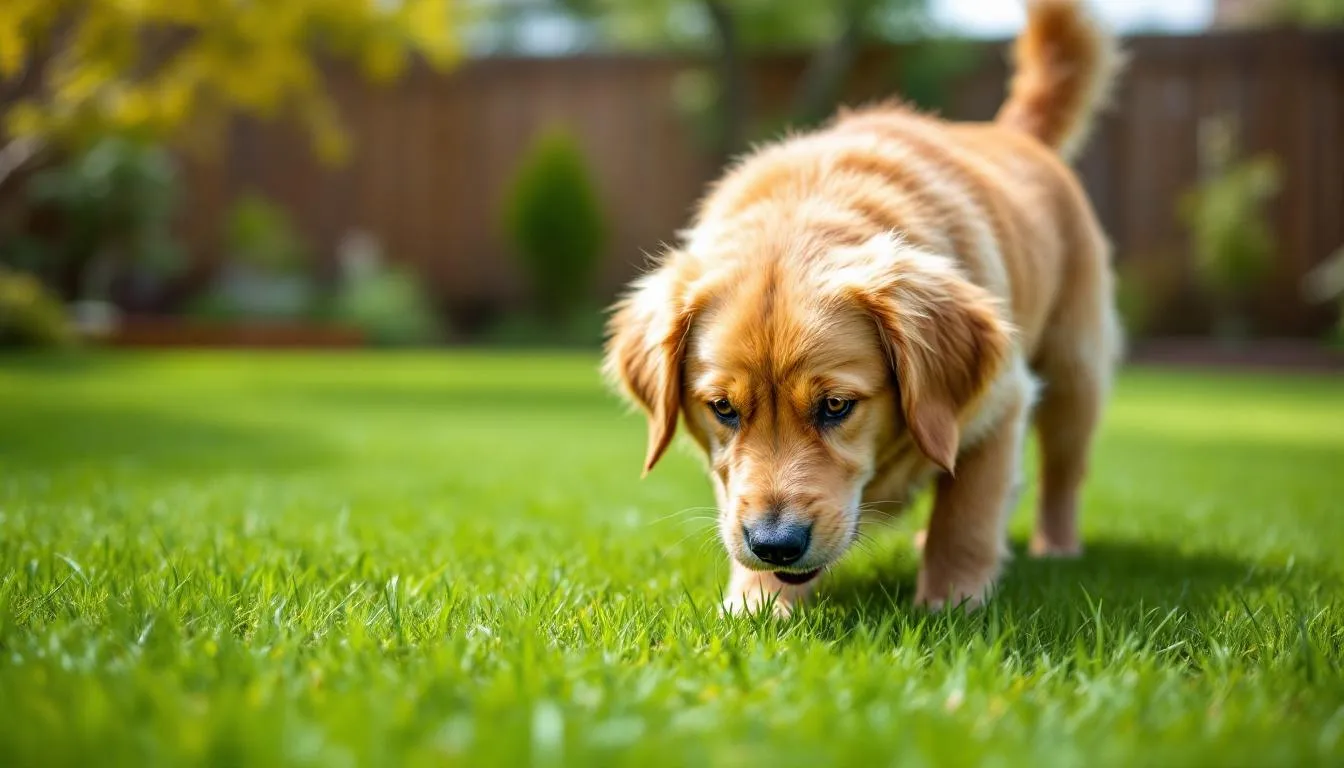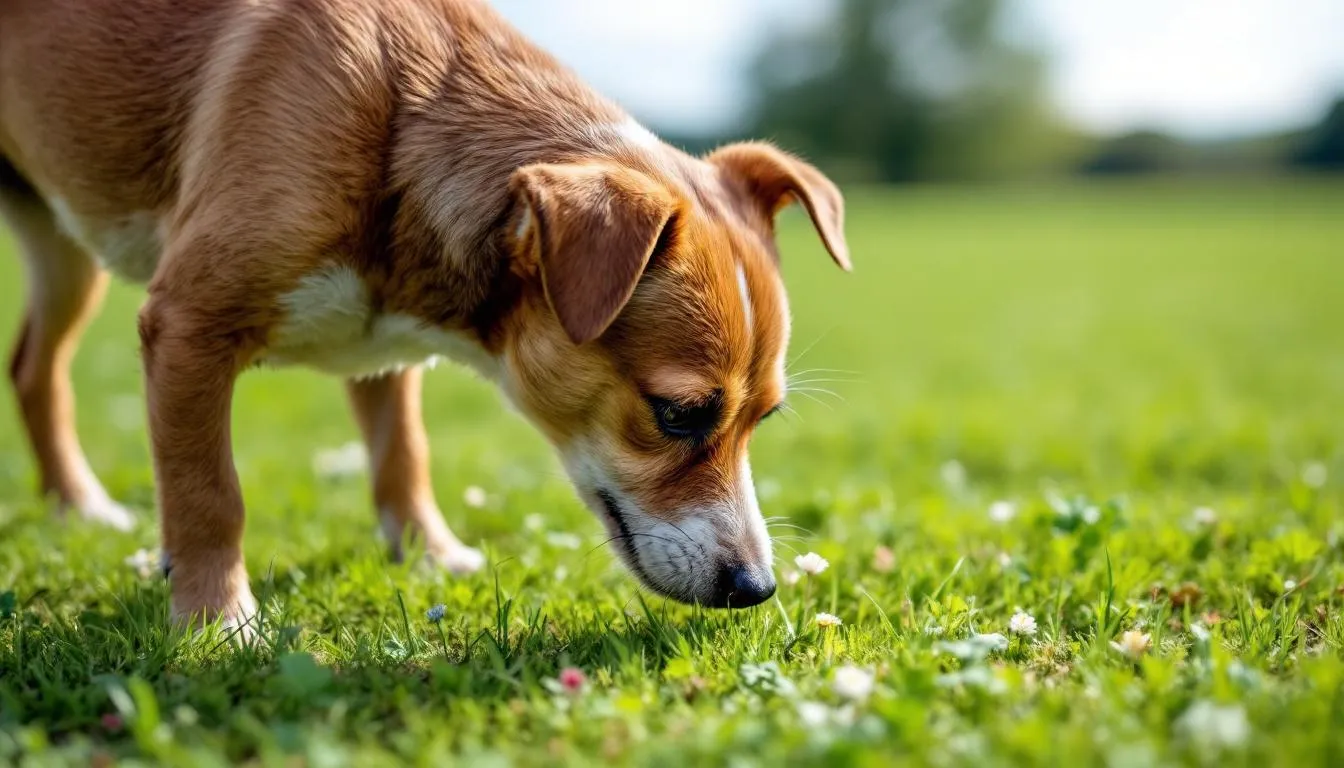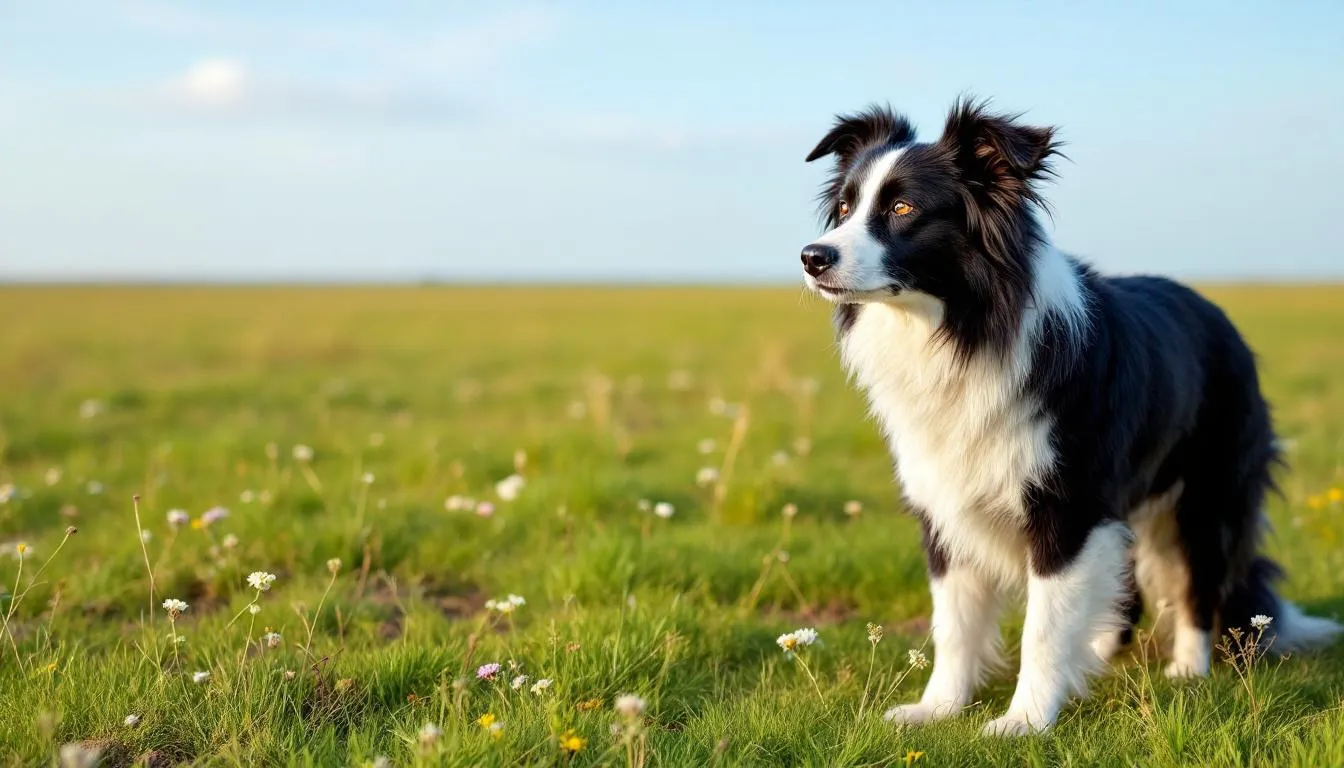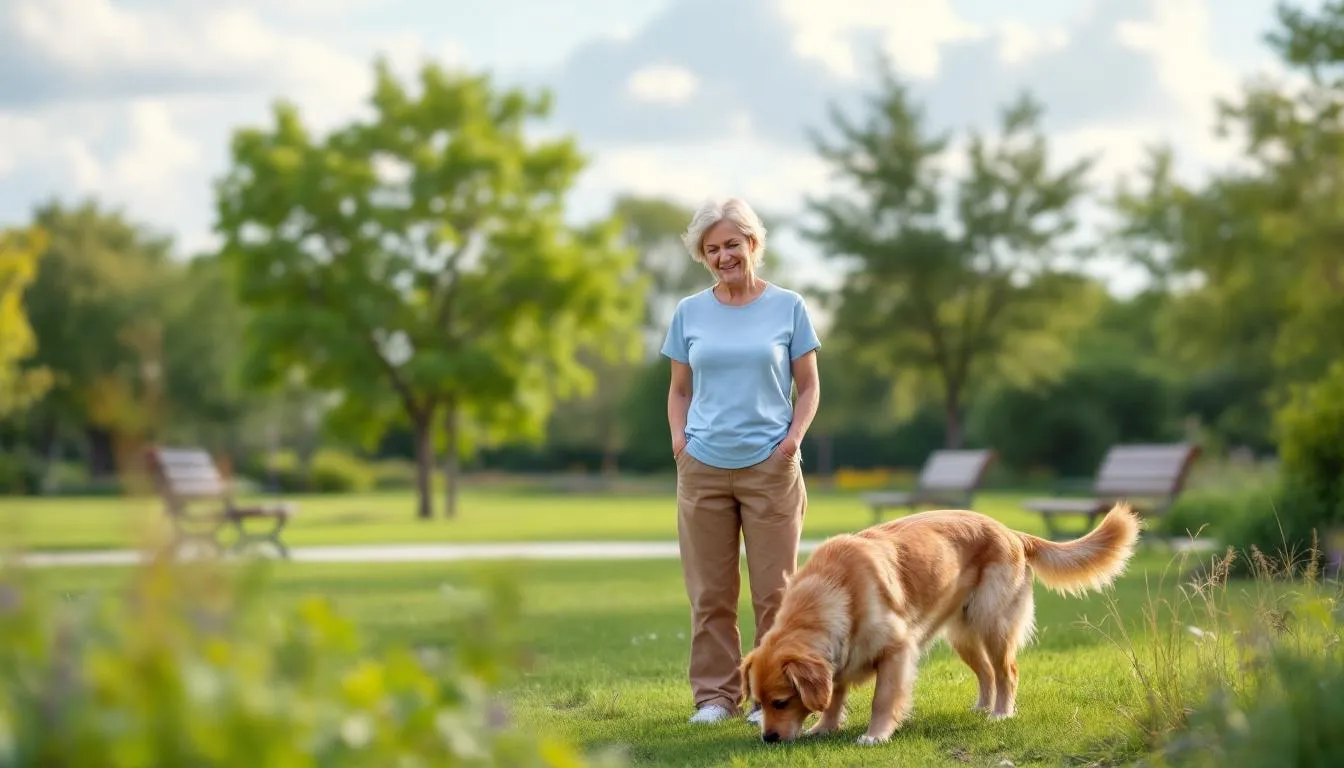

Key Takeaways
Dogs sniff before pooping to communicate with other dogs through scent messages and establish territory
- Dogs sniff before pooping to communicate with other dogs through scent messages and establish territory
- Their powerful sense of smell, up to 100,000 times stronger than humans, helps them gather vital environmental information
- Sniffing ensures they find a safe, comfortable spot while checking for potential threats or other animals
- This behavior is completely normal and rooted in evolutionary survival instincts from their wild ancestors
- The magnetic field of Earth may influence dogs to align along the North-South axis when defecating
Their powerful sense of smell, up to 100,000 times stronger than humans, helps them gather vital environmental information
Sniffing ensures they find a safe, comfortable spot while checking for potential threats or other animals
This behavior is completely normal and rooted in evolutionary survival instincts from their wild ancestors
The magnetic field of Earth may influence dogs to align along the North-South axis when defecating
Every pet parent knows the drill: you’re ready for a quick bathroom break, but your dog has other plans. While you’re standing there wondering why your dog takes forever to find the perfect spot, they’re actually engaged in a complex ritual that’s been millions of years in the making. That pre-poop sniffing isn’t just your dog being picky—it’s a fascinating blend of communication, safety assessment, and evolutionary behavior that reveals just how different the world looks (or rather, smells) to our four-legged companions.
Understanding why dogs sniff before they poop can transform those seemingly endless walks from a source of frustration into a window into your pet’s remarkable sensory world. Let’s explore the science, instincts, and surprising factors that drive this universal canine behavior.
The Science Behind Your Dog’s Super Nose
Your dog’s sense of smell operates on a completely different level than yours. While humans rely primarily on vision to navigate the world, dogs experience the world primarily through scent. The numbers alone are staggering: dogs possess up to 300 million olfactory receptors compared to our measly 6 million. This means when your dog sniffs around before pooping, they’re processing an incredible amount of information that’s completely invisible to you. Dogs are able to detect and interpret scents carried in the air, allowing them to pick up on odors from their environment even before reaching the source.
But the superiority of a dog’s nose goes beyond just quantity. Dogs have a specialized “second nose” called the vomeronasal organ, which allows them to detect pheromones and chemical signals that carry detailed information about other animals. Each nostril can work independently, enabling them to track different scents simultaneously and determine which direction specific smells are coming from.
This biological advantage explains why most dogs seem to take their sweet time sniffing before settling on a bathroom spot. They’re not being indecisive—they’re conducting a thorough environmental assessment using sensory capabilities we can barely imagine. When you see your dog sniff the ground methodically, they’re essentially “reading the newspaper” of their neighborhood, gathering information that’s crucial for their comfort and safety.
Communication Through Scent Marking
Dogs use their bathroom breaks as sophisticated communication systems with other dogs in the area. When dogs sniff before they poop, they’re investigating the messages left behind by previous canine visitors. By smelling these scent messages, dogs interpret and analyze the information left by others. These scent messages contain remarkably detailed information about the dogs who came before, including their sex, age, health status, diet, and even emotional state.
The feces itself serves as a complex calling card thanks to scent glands located in your dog’s rectum. These glands create unique “perfume signatures” that identify each individual dog. When your pet finally does their business, they’re not just relieving themselves—they’re leaving their own detailed message for the next dog to discover.
This scent marking behavior helps establish territory boundaries and social hierarchies among local dogs without the need for direct confrontation. Many dogs will specifically seek out spots where other animals have previously eliminated, either to gather information or to mark over another dog’s scent. This is particularly common with male dogs, who may engage in competitive marking behavior when they detect the presence of other males in their territory.
The information exchange is so sophisticated that dogs can determine whether a female is in heat, identify familiar neighborhood dogs, and even assess potential threats—all through careful sniffing. This is why both you and your dog benefit from allowing adequate time for this natural behavior, as it reduces anxiety and helps your pet feel more secure in their environment.


Finding the Perfect Bathroom Spot
When your dog sniffs around extensively before pooping, they’re conducting a security assessment that goes far beyond finding clean grass. This behavior stems from a deep-seated need to minimize vulnerability during defecation, when dogs are in a compromised position and less able to quickly escape from potential threats. During a walk, this activity of taking your dog outside for a bathroom break gives them the opportunity to thoroughly sniff and select a spot, as the walking route exposes them to a variety of scents and environments that influence their decision.
Dogs instinctively seek locations that offer privacy while maintaining clear escape routes. They prefer spots that feel safe from both predators and other animals that might challenge them. The sniffing process helps them detect recent activity in the area—whether other dogs, cats, or wild animals have been present. Loud noises or sudden movements during this assessment phase can send dogs searching for an entirely new location.
Surface preferences also play a role in the selection process. While some dogs love soft grass, others prefer harder surfaces, and mobility problems in older dogs might influence their choice of terrain. Weather conditions add another layer of complexity: dogs may spend more time sniffing during cold or wet conditions as they search for more comfortable spots.
The thoroughness of this security check explains why your dog might suddenly abandon a spot they seemed to be considering. If they detect something that makes them feel unsafe—whether it’s the scent of a larger, more dominant dog or signs of recent disturbance—they’ll start the search process all over again. This isn’t stubbornness; it’s survival instinct at work.
Evolutionary and Survival Instincts
The reason dogs sniff before they poop traces back to their wild ancestors, who couldn’t afford to be careless about bathroom habits. In the wild, leaving waste in exposed or frequently traveled areas could attract predators or signal weakness to competitors. Pack animals like wolves developed sophisticated protocols around elimination that helped maintain both individual safety and group cohesion.
These evolutionary behaviors persist in domestic dogs despite no longer being essential for survival. Your house pet retains the same cautious approach to bathroom selection that kept their ancestors alive in dangerous environments. For example, a change in your dog's routine or a new environment can disrupt their usual bathroom habits, as they may need extra time to sniff and assess the area before feeling safe enough to go. The thorough sniffing routine serves as a modern echo of ancient survival strategies.
Wild canines also used scent marking as a way to maintain social order within packs and establish territorial boundaries with neighboring groups. This behavior helped reduce direct confrontations by providing a communication system that allowed different groups to understand each other’s presence and territorial claims without violent encounters.
Even puppies display these instinctive behaviors, though they may need time to develop the patience and thoroughness of adult dogs. The behavior is so deeply ingrained that it appears across all dog breeds, regardless of their size, background, or level of domestication. This universal nature of pre-poop sniffing demonstrates just how fundamental this behavior is to canine identity.


The Magnetic Field Theory
Recent research has added a fascinating new dimension to understanding why dogs take so long to find their perfect bathroom spot. Studies conducted by Czech University researchers discovered that dogs tend to align their bodies along the earth’s magnetic field when defecating, specifically preferring the north south axis when magnetic conditions are stable. This behavior demonstrates a clear connection to the earth's magnetic field, indicating that canine instincts or biological responses may be influenced by geomagnetic forces.
The research tracked 70 dogs across 37 different breeds and found a statistically significant preference for this magnetic alignment, though the behavior was most pronounced when the earth’s magnetic field was calm. During periods of magnetic disturbance, this preference became less consistent, suggesting that dogs can actually sense and respond to geomagnetic conditions.
While the exact mechanism behind this magnetic sensitivity remains under investigation, it adds another layer of complexity to the pre-poop sniffing routine. Your dog might be taking extra time not just to assess scents and safety, but also to position themselves according to magnetic cues that are completely imperceptible to humans.
This discovery has generated significant interest in the scientific community, though researchers are still working to understand the practical implications. It’s possible that magnetic alignment provides some form of comfort or orientation benefit to dogs, or it might be connected to other navigational instincts that domestic dogs have retained from their wild heritage.
Pooping Habits and Health
A dog’s pooping habits can reveal a lot about their overall health and well-being. Many dogs are creatures of habit, and changes in their bathroom routine can be an early sign that something isn’t quite right. Pet parents should pay close attention to their dog’s pooping schedule, consistency, and appearance. Unusual changes—like diarrhea, constipation, or blood in the stool—should never be ignored, as they may indicate underlying health issues that require a vet’s attention.
Most dogs rely on their powerful sense of smell not just to find a spot, but also to communicate with other dogs and mark territory. Scent marking is a natural behavior that helps dogs identify their own territory and send messages to other animals in the area. Each dog has a unique scent, and by pooping in a particular location, they’re letting other dogs and animals know who’s been there and possibly warning them to stay away. This is why you might notice your dog returning to the same spot or being especially interested in areas where other dogs have recently been.
Understanding your dog’s pooping habits and the role of scent marking can help you provide better care. If you notice anything unusual about your pet’s bathroom behavior, don’t hesitate to consult your vet. Staying in tune with your dog’s routine is one of the best ways to support their health and happiness and help your friends as you know the answer now. Why Do Dogs Sniff Before They Poop?
When Sniffing Becomes Excessive
While sniffing before pooping is completely normal, there are times when excessive hesitation might signal underlying issues that warrant attention. Mobility problems, particularly in older dogs, can make the squatting position uncomfortable, leading to extended searching behavior as they try to find spots that accommodate their physical limitations. Dogs experiencing trouble with bathroom habits, such as difficulty squatting or going number two, may take longer to find a suitable spot or show signs of discomfort.
Anxiety or stress can also significantly extend your dog’s pre-poop routine. Dogs in unfamiliar environments may spend much more time sniffing around to feel safe enough to eliminate. Changes in routine, new walking routes, or the presence of other dogs can trigger performance anxiety that makes your normally efficient dog suddenly take forever to complete their business.
Health issues can also affect bathroom behavior. Digestive problems, constipation, or anal gland issues might cause discomfort that makes dogs more hesitant to eliminate. If you notice your dog straining, producing unusual feces, or showing signs of distress during elimination, it’s time to consult your vet.
Watch for sudden changes in your dog’s bathroom routine. A dog who typically finds a spot quickly but suddenly becomes very hesitant might be experiencing pain or anxiety that needs attention. Similarly, dogs who seem to avoid their familiar spot or show reluctance to eliminate at all may be dealing with medical issues that require professional evaluation.
Don’t worry if your dog naturally takes a bit longer than others—some pets are simply more cautious or thorough in their assessment process. The key is recognizing when behavior changes significantly from your individual dog’s normal pattern.
Environmental Factors That Influence Sniffing Time
The environment plays a huge role in determining how long your dog will spend sniffing before finding their perfect spot. In unfamiliar territory, most dogs require more extensive scent investigation to feel comfortable enough to eliminate. This is why house guests’ dogs might seem to take forever during their first few walks in your neighborhood.
Weather conditions significantly impact the sniffing process. Cold temperatures might make your dog more selective about exposed areas, while rain can wash away familiar scents, forcing them to conduct a more thorough investigation. Snow presents its own challenges, as it can mask both familiar smells and comfortable surfaces.
High-traffic areas with lots of other animals require more extensive analysis. Dog parks, busy sidewalks, and popular walking routes accumulate complex layers of scent information that take time to process. When two dogs meet in these environments, they often greet each other by sniffing each other's private areas to learn about identity, health, and mood. Your dog isn’t being difficult—they’re working through a overwhelming amount of olfactory data.
The time of day also matters. Morning walks might involve less sniffing if the area has been relatively quiet overnight, while evening walks could require more investigation after a full day of neighborhood activity. Understanding these patterns can help you plan walks more effectively and set realistic expectations for bathroom break duration.
Changes in your usual routine or walking routes will almost certainly increase exploration time. Dogs are creatures of habit, and familiar spots provide comfort and efficiency. When you introduce new areas, expect your dog to spend more time gathering information about these unfamiliar environments.
Reducing Stress and Anxiety During Bathroom Breaks
For many dogs, bathroom breaks can be a source of stress—especially if they take forever to find the right spot. Loud noises like passing trucks, construction, or even other dogs barking can make your pet feel uneasy and hesitant to poop. Pet parents can help by choosing a quiet, familiar spot for bathroom breaks, away from distractions and sudden sounds. Many dogs love to sniff around and explore before pooping, and having a consistent location with familiar scents can make the process smoother and less stressful.
Older dogs or those with mobility problems may need extra time and patience. Health issues can make it harder for them to get comfortable, so allowing them to sniff and move at their own pace is important. Creating a calm environment and giving your dog the freedom to explore and sniff around can help reduce anxiety and make bathroom breaks a more positive experience.
Remember, every dog is different. Some may take their sweet time, while others are quick to do their business. By understanding your dog’s needs and providing a supportive environment, you can help them feel safe and confident during bathroom breaks.
Patience and Understanding: Supporting Your Dog’s Routine
Supporting your dog’s bathroom routine starts with patience and understanding. When your dog sniffs around and takes their sweet time to find the perfect spot to poop, they’re not just being stubborn—they’re following instincts that help them feel safe and comfortable. Some research even suggests that dogs may prefer to align themselves along a north-south axis when pooping, adding another layer of complexity to their routine.
Pet parents can make a big difference by providing a familiar spot for their dog to use, reducing stress, and allowing plenty of time for sniffing and exploring. Let your dog sniff around and investigate their environment; this not only helps them feel secure but also makes bathroom breaks more enjoyable for both you and your pet. When your dog poops in the desired location, reward them with praise or a treat to reinforce good habits.
With time, patience, and a little encouragement, most dogs will develop a reliable potty routine that works for both you and your furry friend. Remember, every dog is unique—embrace their quirks, let them take their time, and enjoy the opportunity to bond during these everyday moments.


Managing Your Dog’s Pre-Poop Routine
The key to managing your dog’s bathroom routine is finding the right balance between allowing natural behavior and maintaining reasonable schedules. Establish consistent walking times and routes when possible, as familiarity helps dogs feel more confident and often reduces the time they need to find their perfect spot.
Choose bathroom areas that are relatively quiet and low in distractions. Busy intersections, areas with lots of foot traffic, or spots near other active dogs can extend the selection process significantly. A familiar spot in your own yard or a quiet section of your regular walking route often works best for efficiency.
Let your dog have adequate time for their natural sniffing behavior without rushing them unnecessarily. Patience during this process actually pays off in the long run, as dogs who feel hurried may develop anxiety around elimination or begin avoiding outdoor bathroom breaks altogether. Use this time as an opportunity to practice your own patience and observe your pet’s fascinating sensory world. Sniffing and exploring outdoors is fun for dogs, providing them with enjoyment and important mental stimulation.
Positive reinforcement can help encourage efficient bathroom habits when appropriate. Reward your dog when they eliminate promptly in suitable locations, but avoid punishment or frustration when they take longer. Remember that excessive pressure can backfire and create elimination problems that are much more difficult to resolve.
During particularly challenging weather or when time is limited, consider having a designated “quick bathroom” area that your dog knows well, while allowing longer exploration walks at other times. This gives you flexibility while still respecting your dog’s natural needs and instincts.
FAQ
How long is normal for a dog to sniff before pooping?
Most dogs take 1-5 minutes to find their preferred spot, though some may take longer in new environments or when distracted. The duration varies based on individual temperament, environmental factors, and the density of scent information in the area. As long as your dog eventually eliminates normally and doesn’t show signs of distress, extended sniffing time is typically nothing to worry about.
Should I stop my dog from sniffing so much before pooping?
No, sniffing is a natural and important behavior that helps dogs feel safe and communicate with their environment. Rushing them can cause stress and anxiety, potentially leading to elimination problems. Instead, allow adequate time for this behavior while establishing consistent routines that can help make the process more efficient over time.
Why does my dog circle multiple times before finally pooping?
Circling helps dogs align with magnetic fields, check for safety, and position themselves comfortably. Multiple circles ensure they’ve found the optimal spot that meets their various criteria for security, comfort, and proper positioning. This behavior is completely normal and serves multiple evolutionary and practical purposes.
Can health problems cause excessive sniffing before pooping?
Yes, arthritis, anal gland issues, digestive problems, or anxiety can all increase the time dogs spend preparing to defecate. If you notice sudden changes in your dog’s bathroom routine, such as excessive hesitation, signs of pain, straining, or avoiding elimination altogether, consult your vet to rule out medical issues.
Do all dog breeds sniff the same amount before pooping?
While the basic behavior is universal among dogs, some breeds with stronger scenting abilities (like hounds) may spend more time investigating scents, while anxious or sensitive breeds might take longer to feel secure. Individual personality, age, health status, and past experiences also influence how thoroughly each dog investigates before eliminating.
Why do dogs sniff certain parts of the body?
Dogs are interested in the body's scents, especially those coming from sweat glands or areas with strong odors. They use their powerful sense of smell to gather information about a person's body, mood, and health. The unique scents found on different parts of the body help dogs learn more about the people they interact with.
FAQ
How long is normal for a dog to sniff before pooping?
Most dogs take 1-5 minutes to find their preferred spot, though some may take longer in new environments or when distracted. The duration varies based on individual temperament, environmental factors, and the density of scent information in the area. As long as your dog eventually eliminates normally and doesn’t show signs of distress, extended sniffing time is typically nothing to worry about.
Should I stop my dog from sniffing so much before pooping?
No, sniffing is a natural and important behavior that helps dogs feel safe and communicate with their environment. Rushing them can cause stress and anxiety, potentially leading to elimination problems. Instead, allow adequate time for this behavior while establishing consistent routines that can help make the process more efficient over time.
Why does my dog circle multiple times before finally pooping?
Circling helps dogs align with magnetic fields, check for safety, and position themselves comfortably. Multiple circles ensure they’ve found the optimal spot that meets their various criteria for security, comfort, and proper positioning. This behavior is completely normal and serves multiple evolutionary and practical purposes.
Can health problems cause excessive sniffing before pooping?
Yes, arthritis, anal gland issues, digestive problems, or anxiety can all increase the time dogs spend preparing to defecate. If you notice sudden changes in your dog’s bathroom routine, such as excessive hesitation, signs of pain, straining, or avoiding elimination altogether, consult your vet to rule out medical issues.
Do all dog breeds sniff the same amount before pooping?
While the basic behavior is universal among dogs, some breeds with stronger scenting abilities (like hounds) may spend more time investigating scents, while anxious or sensitive breeds might take longer to feel secure. Individual personality, age, health status, and past experiences also influence how thoroughly each dog investigates before eliminating.
Why do dogs sniff certain parts of the body?
Dogs are interested in the body's scents, especially those coming from sweat glands or areas with strong odors. They use their powerful sense of smell to gather information about a person's body, mood, and health. The unique scents found on different parts of the body help dogs learn more about the people they interact with.






